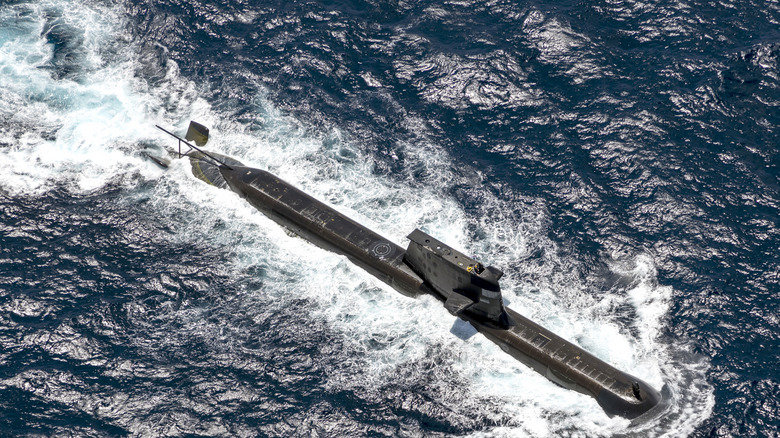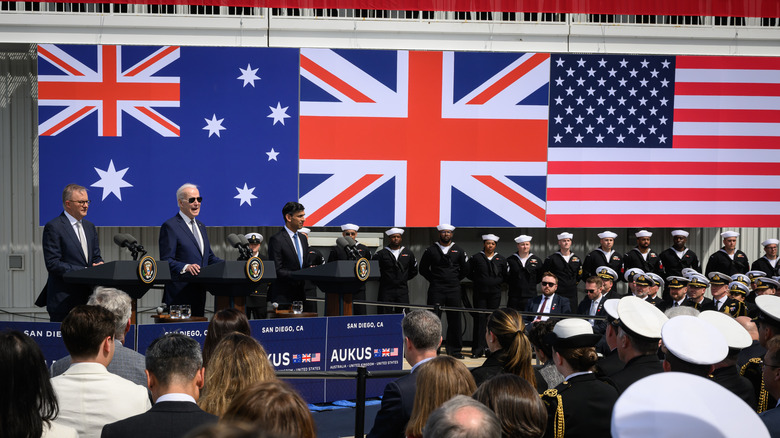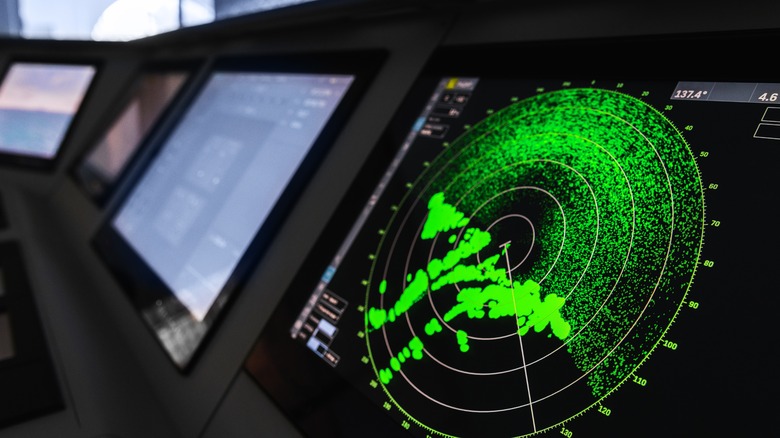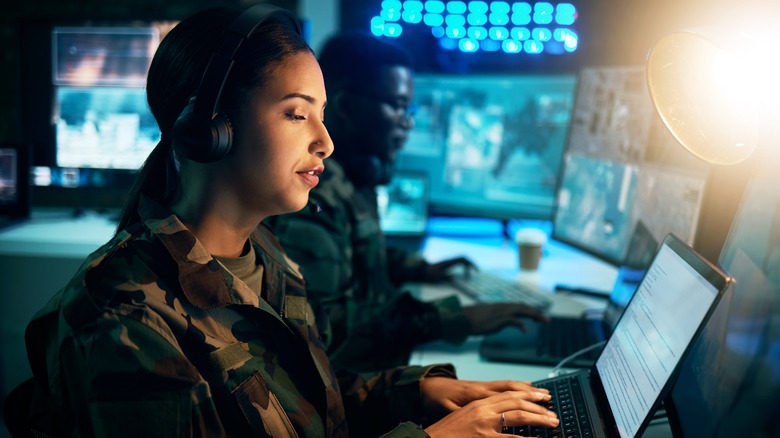Here's How The US Navy Is Planning To Use AI In Submarines
When it comes to submarine warfare, a key challenge that all naval units encounter is stealth. In fact, nuclear-powered submarines deter war thanks to their ability to survive the first strike of a nuclear attack and ability to remain undetected. For this reason, many modern submarines are designed to be nearly impossible to detect. Unfortunately, submarines still rely on sonar technology, which uses sound waves to send and receive signals. Despite sonar's many issues — including detectability and negative impact on marine wildlife and even humans — it's still the most effective method of underwater communication. With this in mind, it's no wonder that this is an area where artificial intelligence (AI) is coming into play.
In November 2023, the Australian government claimed that its naval personnel were injured by the Chinese navy's "unsafe" use of sonar in Japan's exclusive economic zone. During a joint press conference in California just a few weeks later, Australia announced that it would begin testing the use of AI to help track Chinese submarines under a new Aukus plan. Established in September 2021, Aukus is a security alliance formed by Australia, the U.S., and the U.K., with the initial goal of Australia acquiring nuclear submarines. In addition, under its technology agreement, Aukus announced its plan to use AI to help crew members track Chinese submarines faster and more accurately. In 2023, the defense chiefs of the three nations shared that crew flying Pacific missions will use AI algorithms to process sonar data.
AI as part of a holistic naval strategy
Coming on the heels of a landmark submarine deal, Aukus is priming Australia to get ahead of the naval game in the Pacific region in more ways than one. According to the Carnegie Endowment for International Peace, the Aukus unveiled "one of the most ambitious defense industrial partnerships in recent history." To boost Australia's naval forces with nuclear-powered submarines, the United States agreed to sell Australia up to five Virginia-class submarines starting in 2032. Aside from this, it also plans to co-develop a new Aukus-class submarine with the U.K. and Australia by 2040.
In March 2023, the White House published a fact sheet stating that the SSN-AUKUS will be a state-of-the-art platform leveraging the best technology from all three nations. With more than 500 naval nuclear reactors and more than 150 million miles traveled by the U.S. and U.K. forces, Australia is in good hands during its early steps toward adopting nuclear propulsion technology. However, it's critical to take note that Australia remains a non-nuclear weapon state and is committed to not producing nuclear fuel for its SSNs. To mitigate this, the U.S. and U.K. plan to provide Australia with nuclear material in complete, welded power units that will not require any sort of refueling within their expected operational lifetime.
Alongside its newly announced plans for integrating AI with submarines, the Aukus strategy of collective deterrence could also help impact the balance of power in the region.
Integrating AI and submarine surveillance
Among the Aukus pillars, the second pillar covers technology sharing, increasing interoperability, and enhancing capabilities among its members. Aside from artificial intelligence, this pillar also covers cyber capabilities, quantum technology, and other undersea capabilities.
According to an Australian National University study, it's possible that submarines may no longer be able to elude detection by 2050 due to technological advancements. Among these methods, the Australian Strategic Policy Institute says one key development that could undermine nuclear deterrence is underwater drone swarms, which could be used to target submarines that act as deterrents in the context of war. Because of their mobility, they can provide sonar sensors with more accurate data. One can only imagine how working with AI can take underwater drones to the next level.
While the recent announcements by Aukus revealed its plans to use AI for submarines, it has already executed several exercises for its AI-integrated air and ground vehicles. In June 2023, United Kingdom Ministry of Defence James Cartlidge shared that the first Aukus AI and autonomy trial was held in the U.K. in April. In a press release, the U.K. government claimed that the trial — which was organized by the U.K.'s Defence Science and Technology Laboratory — was the first to live train models in flight, among other things.
"I was impressed to see AI models rapidly updated at the tactical edge to incorporate new targets, which were immediately shared among the three partners to deliver decision advantage and meet changing mission requirements," said Australian Deputy Secretary, Strategy, Policy, and Industry Hugh Jeffrey.
The future of AI and marine warfare
It's only a matter of time before countries — especially those that cooperate like the Aukus partnership — can progress their AI applications across military branches to improve their overall operational efficiency. Despite this, the critical race to becoming an AI superpower is still underway, with countries like Israel refusing to back down. From AI-powered turrets to unmanned fighter jets, the role of AI in revolutionizing warfare shouldn't be underestimated — especially its ability to work for or against the existing world order held together by nuclear warheads. With such a wide scope of applications, AI and its ongoing integration with other technologies like robotics and biotechnology could potentially set countries apart in unimaginable and even terrifying ways.
Whether it's using AI for training modules to create more realistic and varied training tools, map the ocean floor better, or introduce more effective health monitoring practices, the use of AI could help soldiers overcome the unique challenges of underwater combat. Through Aukus technological developments, AI is set to play a huge role in terms of naval warfare in the years to come.



